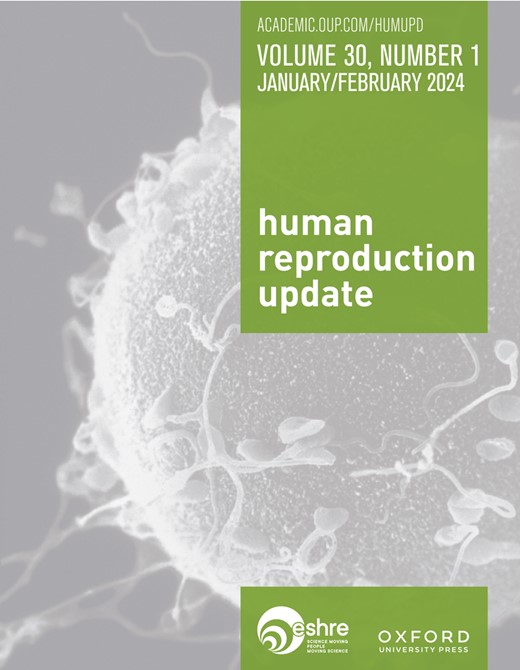Harnessing omics data for drug discovery and development in ovarian aging
IF 16.1
1区 医学
Q1 OBSTETRICS & GYNECOLOGY
引用次数: 0
Abstract
BACKGROUND Ovarian aging occurs earlier than the aging of many other organs and has a lasting impact on women’s overall health and well-being. However, effective interventions to slow ovarian aging remain limited, primarily due to an incomplete understanding of the underlying molecular mechanisms and drug targets. Recent advances in omics data resources, combined with innovative computational tools, are offering deeper insight into the molecular complexities of ovarian aging, paving the way for new opportunities in drug discovery and development. OBJECTIVE AND RATIONALE This review aims to synthesize the expanding multi-omics data, spanning genome, transcriptome, proteome, metabolome, and microbiome, related to ovarian aging, from both tissue-level and single-cell perspectives. We will specially explore how the analysis of these emerging omics datasets can be leveraged to identify novel drug targets and guide therapeutic strategies for slowing and reversing ovarian aging. SEARCH METHODS We conducted a comprehensive literature search in the PubMed database using a range of relevant keywords: ovarian aging, age at natural menopause, premature ovarian insufficiency (POI), diminished ovarian reserve (DOR), genomics, transcriptomics, epigenomics, DNA methylation, RNA modification, histone modification, proteomics, metabolomics, lipidomics, microbiome, single-cell, genome-wide association studies (GWAS), whole-exome sequencing, phenome-wide association studies (PheWAS), Mendelian randomization (MR), epigenetic target, drug target, machine learning, artificial intelligence (AI), deep learning, and multi-omics. The search was restricted to English-language articles published up to September 2024. OUTCOMES Multi-omics studies have uncovered key mechanisms driving ovarian aging, including DNA damage and repair deficiencies, inflammatory and immune responses, mitochondrial dysfunction, and cell death. By integrating multi-omics data, researchers can identify critical regulatory factors and mechanisms across various biological levels, leading to the discovery of potential drug targets. Notable examples include genetic targets such as BRCA2 and TERT, epigenetic targets like Tet and FTO, metabolic targets such as sirtuins and CD38+, protein targets like BIN2 and PDGF-BB, and transcription factors such as FOXP1. WIDER IMPLICATIONS The advent of cutting-edge omics technologies, especially single-cell technologies and spatial transcriptomics, has provided valuable insights for guiding treatment decisions and has become a powerful tool in drug discovery aimed at mitigating or reversing ovarian aging. As technology advances, the integration of single-cell multi-omics data with AI models holds the potential to more accurately predict candidate drug targets. This convergence offers promising new avenues for personalized medicine and precision therapies, paving the way for tailored interventions in ovarian aging. REGISTRATION NUMBER Not applicable.利用组学数据发现和开发卵巢衰老药物
卵巢衰老比许多其他器官的衰老发生得更早,并对女性的整体健康和福祉产生持久的影响。然而,减缓卵巢衰老的有效干预措施仍然有限,主要是由于对潜在的分子机制和药物靶点的了解不完全。组学数据资源的最新进展,结合创新的计算工具,为卵巢衰老的分子复杂性提供了更深入的了解,为药物发现和开发铺平了道路。目的和原理本综述旨在从组织水平和单细胞角度综合与卵巢衰老相关的多组学数据,包括基因组、转录组、蛋白质组、代谢组和微生物组。我们将特别探讨如何利用这些新兴组学数据集的分析来识别新的药物靶点,并指导减缓和逆转卵巢衰老的治疗策略。我们使用一系列相关关键词在PubMed数据库中进行了全面的文献检索:卵巢老化、自然绝经年龄、卵巢功能不全(POI)、卵巢储备功能减退(DOR)、基因组学、转录组学、表观基因组学、DNA甲基化、RNA修饰、组蛋白修饰、蛋白质组学、代谢组学、脂质组学、微生物组学、单细胞、全基因组关联研究(GWAS)、全外显子组测序、全表型关联研究(PheWAS)、孟德尔随机化(MR)、表观遗传靶标、药物靶标、机器学习、人工智能(AI)、深度学习和多组学。搜索仅限于2024年9月之前发表的英文文章。多组学研究揭示了卵巢衰老的关键机制,包括DNA损伤和修复缺陷、炎症和免疫反应、线粒体功能障碍和细胞死亡。通过整合多组学数据,研究人员可以在不同的生物学水平上识别关键的调控因子和机制,从而发现潜在的药物靶点。值得注意的例子包括遗传靶点如BRCA2和TERT,表观遗传靶点如Tet和FTO,代谢靶点如sirtuins和CD38+,蛋白质靶点如BIN2和PDGF-BB,转录因子如FOXP1。前沿组学技术的出现,特别是单细胞技术和空间转录组学,为指导治疗决策提供了有价值的见解,并已成为旨在减轻或逆转卵巢衰老的药物发现的有力工具。随着技术的进步,将单细胞多组学数据与人工智能模型相结合,有可能更准确地预测候选药物靶点。这种融合为个性化医疗和精确治疗提供了有希望的新途径,为卵巢衰老的量身定制干预铺平了道路。注册号不适用。
本文章由计算机程序翻译,如有差异,请以英文原文为准。
求助全文
约1分钟内获得全文
求助全文
来源期刊

Human Reproduction Update
医学-妇产科学
CiteScore
28.80
自引率
1.50%
发文量
38
期刊介绍:
Human Reproduction Update is the leading journal in its field, boasting a Journal Impact FactorTM of 13.3 and ranked first in Obstetrics & Gynecology and Reproductive Biology (Source: Journal Citation ReportsTM from Clarivate, 2023). It specializes in publishing comprehensive and systematic review articles covering various aspects of human reproductive physiology and medicine.
The journal prioritizes basic, transitional, and clinical topics related to reproduction, encompassing areas such as andrology, embryology, infertility, gynaecology, pregnancy, reproductive endocrinology, reproductive epidemiology, reproductive genetics, reproductive immunology, and reproductive oncology. Human Reproduction Update is published on behalf of the European Society of Human Reproduction and Embryology (ESHRE), maintaining the highest scientific and editorial standards.
 求助内容:
求助内容: 应助结果提醒方式:
应助结果提醒方式:


